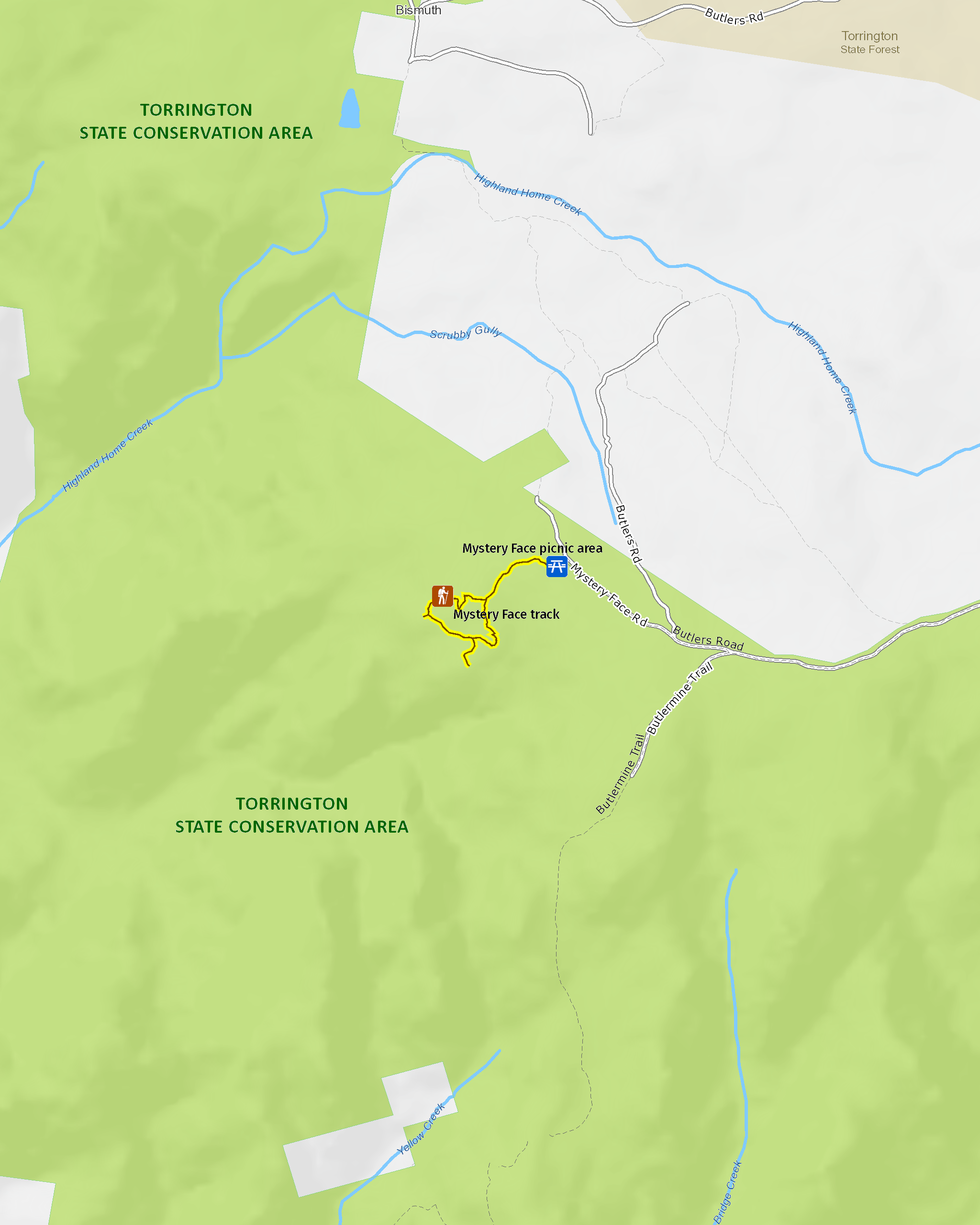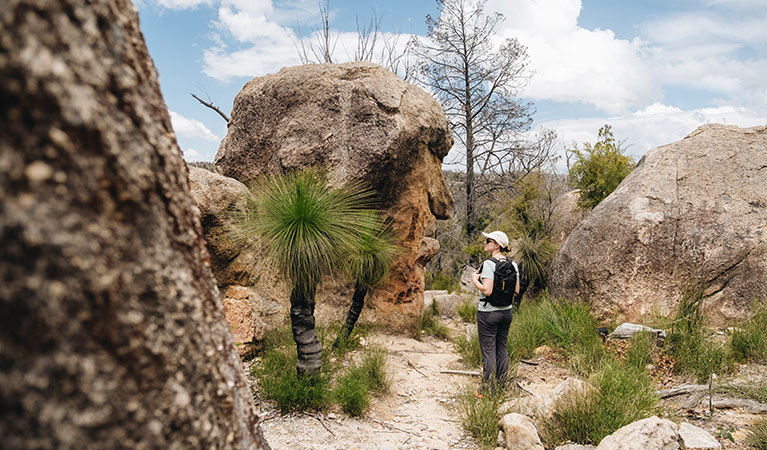Overview
The magnificent rock formations on the Mystery Face walking track are a must-see for any Torrington visitor and great for birdwatching and springtime wildflower displays.
- Accessibility
- No wheelchair access
- Distance
- 2.6km loop
- Time suggested
- 1hr - 1hr 30min
- Grade
- Grade 3
- What to
bring - Hat, sunscreen, drinking water
- Please note
- This park is in a remote location and weather can be unpredictable, please ensure you are thoroughly prepared, bring appropriate clothing and equipment and advise a family member or friend of your travel plans.
The Mystery Face walking track takes you through open woodland and past remarkable granite rock formations. Awaken your imagination and see what shapes and figures you can see along the way.
The Mystery Face itself will be revealed towards the end of the loop track. Worn over time by erosion or created by humans, we’re not sure, but it serves as a fascinating reminder of the ancient Aboriginal heritage of this area.
As you admire the rock formations, keep a look out for small geckos and lizards which are often found in and around the rocky areas during the summer. In spring and summer, you’ll be treated to colourful wildflowers of purples and yellows which are scattered throughout the bush.
For those interested in birdwatching there is also plenty of birdlife to see along the way. You might be lucky to spot the brown treecreeper or the bright red-breasted flame robin dotted amongst the trees.
On the way
-

Mystery Face picnic area
Stop at Mystery Face picnic area before discovering the remarkable rock formations along Mystery Face walking track, in Torrington State Conservation Area, near Tenterfield.
Map

Map legend

Local alerts
For the latest updates on fires, closures and other alerts in this area, see https://www.nationalparks.nsw.gov.au/things-to-do/walking-tracks/mystery-face-walking-track/local-alerts
General enquiries
- National Parks Contact Centre
- 7am to 7pm daily
- 1300 072 757 (13000 PARKS) for the cost of a local call within Australia excluding mobiles
- parks.info@environment.nsw.gov.au
Park info
- in Torrington State Conservation Area in the Country NSW region
Torrington State Conservation Area is always open but may have to close at times due to poor weather or fire danger.
Visitor info
All the practical information you need to know about Mystery Face walking track.
Track grading
Features of this track
Distance
2.6km loop
Time
1hr - 1hr 30min
Quality of markings
Sign posted
Experience required
No experience required
Gradient
Gentle hills
Quality of path
Formed track, some obstacles: The walk is 1.2m-wide and very rocky with some small sections of hard-packed gravel.
Steps
Occasional steps: There are no built steps on this walk, but most of the track is rocky ground, with many ups and downs.
Other barriers
Pinch points: There are many pinch points along the walk due to rocks.
Getting there and parking
On entering Torrington State Conservation Area:
- Follow the Mystery Face signpost and take a right turn at the old pub into Silent Grove Road
- Drive for approximately 2.5km to the Butlers Road turnoff on the left, where the road becomes unsealed.
- Follow Butlers Road and the signposts for about 4.5km
Road quality
Check the weather before you set out as the road to Mystery Face walking track can become boggy when it rains.
Parking
Parking is available nearby at the Mystery Face picnic area.
Best times to visit
There are lots of great things waiting for you in Torrington State Conservation Area. Here are some of the highlights.
Spring
See the spectacular display of spring wildflowers as the boronias, grevilleas, prostantheras and many other native wildflowers turn the bush into a vibrant display of colour.
Summer
Wander through the bush, dotted with colourful wildflowers, as you take in the magnificent granite formations on the Mystery Face walking track.
Weather, temperature and rainfall
Summer temperature
Average
13°C and 31°C
Highest recorded
41.2°C
Winter temperature
Average
1°C and 19°C
Lowest recorded
-10.6°C
Rainfall
Wettest month
January
Driest month
June
The area’s highest recorded rainfall in one day
361.2mm
Facilities
- There are toilets at Mystery Face picnic area where this walk begins.
- Drinking water is not available in this area so it’s a good idea to bring your own.
Maps and downloads
Accessibility
Disability access level - no wheelchair access
- Mystery Face walking track is a 1.2m-wide track with gentle hills.
- Although there are no built steps, most of the walk is very rocky with many ups and downs. The rough track surface makes it unsuitable for wheelchairs, prams and mobility scooters.
- The walk narrows in many places due to rocks and other natural features.
- The toilets at the picnic area where this walk begins are not accessible or ambulant.
Prohibited
Pets
Pets and domestic animals (other than certified assistance animals) are not permitted. Find out which regional parks allow dog walking and see the pets in parks policy for more information.
Pets and domestic animals (other than certified assistance animals) are not permitted in this park. Find out more about pets in parks.
Smoking
NSW national parks are no smoking areas.
Learn more
Mystery Face walking track is in Torrington State Conservation Area. Here are just some of the reasons why this park is special:
Bush experiences

Take in the dramatic views, magnificent rock formations and stunning wildflowers on the many walking tracks. Set up camp at Blatherarm campground or just spend an afternoon relaxing and picnicking at the various picnic areas. And if you are an experienced bushwalker looking for adventure, why not go exploring by foot into the remote corners in the north.
- Mystery Face walking track The magnificent rock formations on the Mystery Face walking track are a must-see for any Torrington visitor and great for birdwatching and springtime wildflower displays.
- Thunderbolts lookout walking track Follow this walking track to see the spectacular 360° panoramic views of Torrington at Thunderbolts lookout. Experience the stunning wildflowers along the way.
Fabulous flowers and wonderful wildlife

This area is home to over 750 plant species, including 45 rare or threatened species like the rare Beadle’s grevillia and Torrington wattle. In fact, some plant communities thrive in the sedge-heath swamps and mole granite outcrops and can’t be found anywhere else in the world. From September to March the bush is ablaze with colour for the spectacular wildflower display. The unique climatic conditions make Torrington a haven for Australian wildlife. It’s home to 20 mammal, 135 bird, 29 reptile and 13 frog species, including threatened species like the powerful owl and the tiger quoll. You’ll probably see grey kangaroos and wallabies in the distance, and kookaburras and currawongs in the trees overhead. But if you’re lucky, you might also spot rare birds like the striking turquoise parrot and rare regent honeyeater.
- Mystery Face walking track The magnificent rock formations on the Mystery Face walking track are a must-see for any Torrington visitor and great for birdwatching and springtime wildflower displays.
- Ugly Corner Falls walking track The Ugly Corner Falls walking track is a fantastic way to get back to nature and experience the unique plants and animals of Torrington.
Land of Dreaming

Torrington State Conservation Area is a significant place for the Ngarrabul, Marbul, Bigambul and Jucumbul people. The land and waterways of Torrington, and the plants and animals that live in them, feature in all facets of Aboriginal culture and are associated with dreaming stories told to this day.
Mining heritage

Go back in time to the by-gone era of mining on the Mole Tableland when hopefuls came from as far as England and China to explore the deposits of tin and other minerals. At its peak in the 1920s, Torrington and nearby villages swelled to accommodate around 600 miners, but sharply declined in 1946 when mining virtually stopped. Try your luck fossicking for semi-precious gemstones like beryl, emerald, topaz and quartz.

